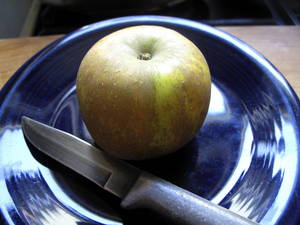The Roxbury Russet apple might be the best heirloom fruit you've never tasted

Janice Leach | Contributor
Jim explained a Roxbury Russet apple to our friend Jay.
"It’s small, and very, very hard, and covered with a brownish sandpapery skin."
Replied Jay, "What you’ve described is the worst advertisement for an apple that I’ve ever heard." But don’t be fooled by the exchange.
A Roxbury Russet apple is truly a secret treasure of fall.
When I was a kid, I thought an apple was an apple. I don’t remember any knowledge of choices or different types, even. Apples were red or green. Sometime later as a grown up, I started paying more attention; I discovered varieties and that I liked some better than others.
We were living in Toronto when my relationship with apples changed. For lunch one day, my best friend brought me a Roxbury Russet apple that she’d purchased from Kensington Market.
True, the Roxbury Russet is no beauty by usual North American consumer standards. It’s not big or red and shiny. The peel is a brownish yellow, and the skin texture is something like a fine sandpaper or felt. It's heavy for its size and very hard.
Eating that first Roxbury Russet was stepping through the doorway to discovering the vast variety of apples that exist and the range of tastes and textures that can delight us. The Roxbury Russet became my very favorite apple.
When we moved back to Michigan, I was saddened by the thought of leaving the Roxbury Russet apple behind. We decided to plant an apple tree in our yard, and we found a heirloom nursery, Trees of Antiquity, that had Roxbury Russet stock available. Our tree is not yet at the producing stage, so we have that to look forward to.
Fortunately, I discovered Roxbury Russet apples for sale at the Farmers’ Market in Ann Arbor. I was thrilled. Now each fall, I make trips to our market and check with the folks at Wasem’s table to find out when the Russets will be ready. Roxbury Russets are a late-ripening apple, but the wait is worth it.
The composition class I'm teaching was finishing up on discussion a series of articles about food and health, so I brought in some Russets to slice up and share. I wanted a concrete demonstration of how food choices are limited when the focus is on narrow standards of attractiveness and how heirloom varieties have gotten pushed aside when marketability drives production.
I don’t know if I made my points successfully, but I did see a lot of satisfied crunching taking place. There were no leftovers to take home.
Sharing a secret is an innately risky business, so I thought twice about writing this post. Maybe there will be a run on Russet apples and I won’t get my fix. Or maybe someone else will be motivated to look beyond the Roxbury Russets’ curious appearance and discover a new favorite apple.
What kind of apple can you not do without?
Janice and Jim Leach tend a backyard plot in downtown Ann Arbor, where they try to grow as many vegetables and other plants as possible. For the last four years, they've published gardening tips, photos and stories at their 20 Minute Garden website.


Comments
NCTerry
Sun, Nov 20, 2011 : 11:01 p.m.
Very enjoyable read. I used to live on the edge of an orange grove just off of the Indian River on the Space Coast of Florida. We also had a few grapefruit trees in our yard. I learned very quickly that the fruit in the grocery store looked a lot different than what grew on the local trees. The oranges weren't all bright and shiny with perfectly smooth skin. Some had brown and tan patches. Some were mottled with green. However, I discovered that the look had nothing to do with the taste. Dye and wax make them look pretty, but don't help the inside. Thankfully I now know not to worry about how produce looks on the outside. I'm glad people are now discovering heirloom and other varieties that may not look perfect, but are loaded with flavor.